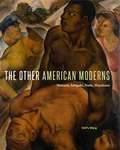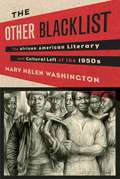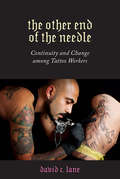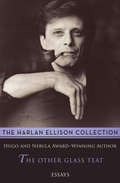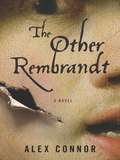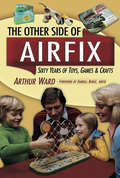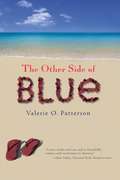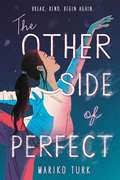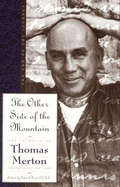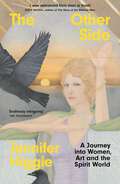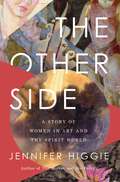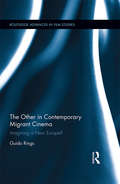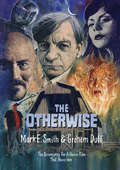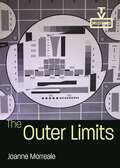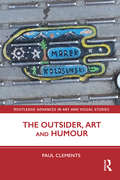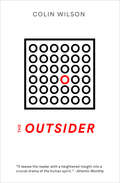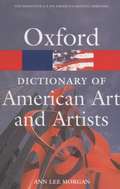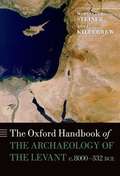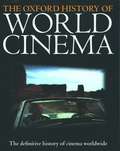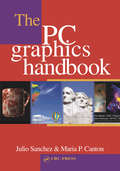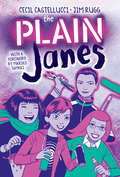- Table View
- List View
The Other American Moderns: Matsura, Ishigaki, Noda, Hayakawa
by ShiPu WangIn The Other American Moderns, ShiPu Wang analyzes the works of four early twentieth-century American artists who engaged with the concept of “Americanness”: Frank Matsura, Eitarō Ishigaki, Hideo Noda, and Miki Hayakawa. In so doing, he recasts notions of minority artists’ contributions to modernism and American culture.Wang presents comparative studies of these four artists’ figurative works that feature Native Americans, African Americans, and other racial and ethnic minorities, including Matsura and Susan Timento Pose at Studio (ca. 1912), The Bonus March (1932), Scottsboro Boys (1933), and Portrait of a Negro (ca. 1926). Rather than creating art that reflected “Asian aesthetics,” Matsura, Ishigaki, Noda, and Hayakawa deployed “imagery of the Other by the Other” as their means of exploring, understanding, and contesting conditions of diaspora and notions of what it meant to be American in an age of anti-immigrant sentiment and legislation.Based on a decade-long excavation of previously unexamined collections in the United States and Japan, The Other American Moderns is more than a rediscovery of “forgotten” minority artists: it reconceives American modernism by illuminating these artists’ active role in the shaping of a multicultural and cosmopolitan culture. This nuanced analysis of their deliberate engagement with the ideological complexities of American identity contributes a new vision to our understanding of non-European identity in modernism and American art.
The Other Blacklist: The African American Literary and Cultural Left of the 1950s
by Mary WashingtonMary Helen Washington recovers the vital role of 1950s leftist politics in the works and lives of modern African American writers and artists. While most histories of McCarthyism focus on the devastation of the blacklist and the intersection of leftist politics and American culture, few include the activities of radical writers and artists from the Black Popular Front. Washington's work incorporates these black intellectuals back into our understanding of mid-twentieth-century African American literature and art and expands our understanding of the creative ferment energizing all of America during this period.Mary Helen Washington reads four representative writers—Lloyd Brown, Frank London Brown, Alice Childress, and Gwendolyn Brooks—and surveys the work of the visual artist Charles White. She traces resonances of leftist ideas and activism in their artistic achievements and follows their balanced critique of the mainstream liberal and conservative political and literary spheres. Her study recounts the targeting of African American as well as white writers during the McCarthy era, reconstructs the events of the 1959 Black Writers' Conference in New York, and argues for the ongoing influence of the Black Popular Front decades after it folded. Defining the contours of a distinctly black modernism and its far-ranging radicalization of American politics and culture, Washington fundamentally reorients scholarship on African American and Cold War literature and life.
The Other End of the Needle: Continuity and Change among Tattoo Workers (Inequality at Work: Perspectives on Race, Gender, Class, and Labor)
by David C. LaneThe Other End of the Needle demonstrates that tattooing is more complex than simply the tattoos that people wear. Using qualitative data and an accessible writing style, sociologist Dave Lane explains the complexity of tattoo work as a type of social activity. His central argument is that tattooing is a social world, where people must be socialized, manage a system of stratification, create spaces conducive for labor, develop sets of beliefs and values, struggle to retain control over their tools, and contend with changes that in turn affect their labor. Earlier research has examined tattoos and their meanings. Yet, Lane notes, prior research has focused almost exclusively on the tattoos—the outcome of an intricate social process—and have ignored the significance of tattoo workers themselves. "Tattooists," as Lane dubs them, make decisions, but they work within a social world that constrains and shapes the outcome of their labor—the tattoo. The goal of this book is to help readers understand the world of tattoo work as an intricate and nuanced form of work. Lane ultimately asks new questions about the social processes occurring prior to the tattoo’s existence.
The Other Glass Teat: Essays
by Harlan EllisonIn the late 1960s, Harlan Ellison launched a weekly column for the Los Angeles Free Press, where he uncompromisingly discussed the effects of television on modern society. He assaulted everything from television sitcoms to corrupt politicians, talk shows to military massacres. Today, more than four decades later, almost all of his criticism still holds true. Open Road and Edgeworks Abbey, Ellison's company, are proud to make this second volume of fifty-two outspoken columns widely available.
The Other Rembrandt
by Alex ConnorA centuries-old conspiracy is about to explode into the present and shake the art world to its core as a relentless serial killer strikes in both London and New York. The first victim was forced to swallow stones. The second was whipped to death. The third was stabbed in the heart. What did they know? Why were they in the killer's sights? Only Marshall Ziegler, the son of one the victims, can discover the dark secret of one of the world's most famous artists before the killer can strike again.
The Other Side Of Airfix: Sixty Years of Toys, Games & Crafts
by Arthur WardAirfix is synonymous with plastic model kits. The brand name has virtually become a noun, occupying a special place in that lexicon of trade names alongside Hoover, Sellotape, Perspex and Aqua-Lung.Throughout the war years Airfix survived on government contracts for a whole range of plastic items and by virtue of Kove's tenancious apetitie for business and doing a deal. By the war's end Airfix was the market leader in plastic injection moulded combs in Britain. By the time Airfix had released its first proper construction kit, a tiny model of Drake's flagship Golden Hind, in 1952, the firm was well established as a leading toy brand. Indeed throughout the 1950s, 60s and 70s Airfix invested heavily in developing new toys or manufacturing them under license for large US toy companies such as Hasbro. Very soon Airfix extended its activities beyond toys into games and arts and crafts and in short time famous names.Indeed so successful was Airfix at diversifying that by the 1970s the company had grown to such an extent that it had acquired other famous toy brands including Dinky Toys, Tri-ang, Meccano, and Romper Room. With its subsidiary Crayonne Airfix even harnessed the design talents of the then Terence Conranne in attempt to elevate plastic products to the rarified atmosphere of designer chic.So there's a lot more to Airfix than many might think and this book is the first attempt to document the myriad successful lines, outside of plastic kits, which contributed to the company's dramatic growth before a combination of factors forced it into brief liquidation in 1981. Written by someone with a lifetime's fascination for Airfix and who has written other books about the better known construction kit side of the business, The Other Airfix is a nostalgic trip down memory lane.
The Other Side of Blue
by Valerie O. PattersonCyan was named after a shade of blue, her artist mother's favorite color. The color of the sea. Since her father's death last year, she's felt just as mercurial and dark as her namesake, and the distance between Cyan and her mother has grown as wide as an ocean. Now they're returning to the island of Curaçao in the Caribbean, where her father's mysterious accident occurred, and joining them will be Kammi--who may soon become a stepsister. Haunted by the secrets of the past, Cyan will explore all the depths of her blueness this summer, discovering the light, the darkness, and the many shades in between that are within her-and within us all.
The Other Side of Perfect
by Mariko TurkFor fans of Sarah Dessen and Mary H.K. Choi, this lyrical and emotionally driven novel follows Alina, a young aspiring dancer who suffers a devastating injury and must face a world without ballet—as well as the darker side of her former dream. Alina Keeler was destined to dance, but then a terrifying fall shatters her leg—and her dreams of a professional ballet career along with it.After a summer healing (translation: eating vast amounts of Cool Ranch Doritos and binging ballet videos on YouTube), she is forced to trade her pre-professional dance classes for normal high school, where she reluctantly joins the school musical. However, rehearsals offer more than she expected—namely Jude, her annoyingly attractive castmate she just might be falling for.But to move forward, Alina must make peace with her past and face the racism she experienced in the dance industry. She wonders what it means to yearn for ballet—something so beautiful, yet so broken. And as broken as she feels, can she ever open her heart to someone else?Touching, romantic, and peppered with humor, this debut novel explores the tenuousness of perfectionism, the possibilities of change, and the importance of raising your voice.
The Other Side of the Mountain: The End of the Journey (The Journals of Thomas Merton #7)
by Thomas MertonWith the election of a new Abbot at the Abbey of Gethsemani, Merton enters a period of unprecedented freedom, culminating in the opportunity to travel to California, Alaska, and finally the Far East - journeys that offer him new possibilities and causes for contemplation. In his last days at the Abbey of Gethsemani, Merton continues to follow the tumultuous events of the sixties, including the assassinations of Martin Luther King, Jr., and Robert Kennedy. In Southeast Asia, he meets the Dalai Lama and other Buddhist and Catholic monks and discovers a rare and rewarding kinship with each. The final year is full of excitement and great potential for Merton, making his accidental death in Bangkok, at the age of fifth-three, all the more tragic.
The Other Side: A Journey into Women, Art and the Spirit World
by Jennifer Higgie'Endlessly intriguing . . . I was enchanted' - DAILY TELEGRAPH'Illuminating in every sense of the word' - John HiggsIn an illuminating blend of memoir and art history, The Other Side explores the lives and work of a group of extraordinary women artists. From the twelfth-century mystic Hildegard of Bingen and the nineteenth-century spiritualist Georgiana Houghton to the pioneering Hilma af Klint, these women all - in their own unique ways - shared the same goal: to communicate with, and learn from, other dimensions. Weaving in and out of their myriad lives, Jennifer Higgie considers the solace of ritual, the gender exclusions of art history, the contemporary relevance of myth, the boom in alternative ways of understanding the world and the impact of spiritualism on feminism and contemporary art.
The Other Side: A Story of Women in Art and the Spirit World
by Jennifer HiggieThe first major work of art history to focus on women artists and their engagement with the spirit world, by the author of The Mirror and the Palette.It's not so long ago that a woman's expressed interest in other realms would have ruined her reputation, or even killed her. And yet spiritualism, in various incarnations, has influenced numerous men—including lauded modernist artists such as Wassily Kandinsky, Piet Mondrian, Kazimir Malevich and Paul Klee—without repercussion. The fact that so many radical female artists of their generation—and earlier—also drank deeply from the same spiritual well has been sorely neglected for too long. In The Other Side, we explore the lives and work of a group of extraordinary women, from the twelfth-century mystic, composer, and artist Hildegard of Bingen to the nineteenth-century English spiritualist Georgiana Houghton, whose paintings swirl like a cosmic Jackson Pollock; the early twentieth-century Swedish artist, Hilma af Klint, who painted with the help of her spirit guides and whose recent exhibition at New York's Guggenheim broke all attendance records to the 'Desert Transcendentalist', Agnes Pelton, who painted her visions beneath the vast skies of California. We also learn about the Swiss healer, Emma Kunz, who used geometric drawings to treat her patients and the British surrealist and occultist, Ithell Colquhoun, whose estate of more than 5,000 works recently entered the Tate gallery collection. While the individual work of these artists is unique, the women loosely shared the same goal: to communicate with, and learn from, other dimensions. Weaving in and out of these myriad lives while sharing her own memories of otherworldly experiences, Jennifer Higgie discusses the solace of ritual, the gender exclusions of art history, the contemporary relevance of myth, the boom in alternative ways of understanding the world and the impact of spiritualism on feminism and contemporary art. A radical reappraisal of a marginalized group of artists, The Other Side is an intoxicating blend of memoir, biography, and art history.
The Other in Contemporary Migrant Cinema: Imagining a New Europe? (Routledge Advances in Film Studies #46)
by Guido RingsAs a rapidly aging continent, Europe increasingly depends on the successful integration of migrants. Unfortunately, contemporary political and media discourses observe and frequently also support the development of nationalist, eurosceptic and xenophobic reactions to immigration and growing multiethnicity. Confronting this trend, European cinema has developed and disseminated new transcultural and postcolonial alternatives that might help to improve integration and community cohesion in Europe, and this book investigates these alternatives in order to identify examples of good practices that can enhance European stability. While the cinematic spectrum is as wide and open as most notions of Europeanness, the films examined share a fundamental interest in the Other. In this qualitative film analysis approach, particular consideration is given to British, French, German, and Spanish productions, and a comparison of multiethnic conviviality in Chicano cinema.
The Otherwise: The Screenplay for a Horror Film That Never Was
by Graham Duff Mark E SmithThe first ever publication of Mark E. Smith's supernatural film treatment, co-authored with Graham Duff.In 2015 Mark E. Smith of The Fall and screenwriter Graham Duff co-wrote the script for a horror feature film called The Otherwise. The story involved The Fall recording an EP in an isolated recording studio on Pendle Hill. The Lancashire landscape is not only at the mercy of a satanic biker gang, it's also haunted by a gaggle of soldiers who have slipped through time from the Jacobite Rebellion.However, every film production company who saw the script said it was 'too weird' to ever be made. The Otherwise is weird. Yet it's also witty, shocking and genuinely scary. Now the screenplay is published for the first time, alongside photographs, drawings and handwritten notes. The volume also contains previously unpublished transcripts of conversations between Smith and Duff, where they discuss creativity, dreams, musical loves (from Can to acid house) and favourite films (from Britannia Hospital to White Heat). Smith also talks candidly about his youth and mortality, in exchanges that are both touching and extremely funny.
The Outer Limits (TV Milestones Series)
by Joanne MorrealeIn this TV Milestone, author Joanne Morreale highlights the differences of The Outer Limits (ABC 1963–65) from typical programs on the air in the 1960s. Morreale argues that the show provides insight into changes in the television industry as writers turned to genre fiction—in this case, a hybrid of science fiction and horror—to provide veiled social commentary. The show illustrates the tension between networks who wanted mainstream entertainment and the independent writer-producers, Leslie Stevens and Joseph Stefano, who wanted to use the medium to challenge viewers. In five chapters, The Outer Limitsmakes a case for the show’s deployment of gothic melodrama and science fiction tropes, unique televisual characteristics, and creative adaptation of many cultural sources to interrogate the relationship between humans and technology in a way that continues to influence contemporary debate in such shows as Star Trek, The X-Files, and Black Mirror. Underlying the arguments is the eerie notion of The Outer Limits as a disruptive force on television at the time, purposely making audiences uncomfortable. For example, in its iconic opening credit sequence a disembodied "Control Voice" claims to be taking over the television as images mimic signal interference. Other themes convey Cold War paranoia, ambivalence about the Kennedy era "New Frontier," and anxiety about the burgeoning military-industrial-governmental complex. The book points out that The Outer Limits presaged what came to be known as "quality" television. While most episodes followed the lowbrow tradition of televised science fiction by adapting previously published stories and films, the series elevated the genre by rearticulating it through themes and images drawn from myth, literature, and the art film. The Outer Limits is lucid yet accessible, well researched and argued, with enlightening discussions of specific episodes even as it gives attention to broader television history and theory. It will be of special interest to scholars and students of television and media studies, as well as fans of science fiction.
The Outsider, Art and Humour (Routledge Advances in Art and Visual Studies)
by Paul ClementsThis cross-disciplinary book, situated on the periphery of culture, employs humour to better comprehend the arts, the outsider and exclusion, illuminating the ever-changing social landscape, the vagaries of taste and limits of political correctness. Each chapter deals with specific themes and approaches – from the construct of outsider and complexity of humour, to Outsider Art and spaces – using various theoretical and analytical methods. Paul Clements draws on humour, especially from visual arts and culture (and to a lesser extent literature, film, music and performance), as a tool of ridicule, amongst other discourses, employed by the powerful but also as a weapon to satirize them. These ambiguous representations vary depending on context, often assimilated then reinterpreted in a game of authenticity that is poignant in a world of facsimile and 'fake news'. The humour styles of a range of artists are highlighted to reveal the fluidity and diversity of meaning which challenges expectations and at its best offers resistance and, crucially, a voice for the marginal. This book will be of particular interest to scholars in art history, cultural studies, fine art, humour studies and visual culture.
The Outsider: A Study Of Sexual Outsiders (Picador Bks. #Vol. 6)
by Colin WilsonThe classic study of alienation, existentialism, and how great artists have portrayed characters who exist on the margins of society. Published to immense acclaim in the mid-1950s, The Outsider helped make popular the literary concept of existentialism. Authors like Sartre, Kafka, Hemingway, and Dostoyevsky, as well as artists like Van Gogh and Nijinsky, delved for a deeper understanding of the human condition in their work, and Colin Wilson&’s landmark book encapsulated a character found time and time again: the outsider. How does the outsider influence society? And how does society influence him? It&’s a question as relevant to today&’s iconic characters, from Don Draper to Voldemort, as it was when The Outsider was initially published. A fascinating study blending philosophy, psychology, and literature, Wilson&’s seminal work is a must-have for those who are fascinated by the character of the outsider. &“Luminously intelligent . . . A real contribution to our understanding of our deepest predicament.&” —Philip Toynbee &“Leaves the reader with a heightened insight into a crucial drama of the human spirit.&” —Atlantic Monthly
The Owls Are Not What They Seem: Artist as Ethologist (Forerunners: Ideas First)
by Arnaud GerspacherToward a posthumanist art and ethologyThe Owls Are Not What They Seem is a selective history of modern and contemporary engagements with animals in the visual arts and how these explorations relate to the evolution of scientific knowledge regarding animals. Arnaud Gerspacher argues that artistic knowledge, with its experimental nature, ability to contain contradictions, and more capacious understanding of truth-claims, presents a valuable supplement to scientific knowledge when it comes to encountering and existing alongside nonhuman animals and life worlds. Though critical of art works involving animals that are unreflective and exploitative, Gerspacher&’s exploration of aesthetic practices by Allora & Calzadilla, Pierre Huyghe, Agnieszka Kurant, Araya Rasdjarmrearnsook, Martin Roth, David Weber-Krebs, and others suggests that, alongside scientific practices, art has much to offer in revealing the otherworldly qualities of animals and forging ecopolitical solidarities with fellow earthlings.
The Oxford Companion to American Theatre
by Gerald BordmanAn abridgment of the massive original volume (1984), eliminating many entries on minor plays and figures but preserving those articles that are of the widest general interest. In addition, this volume updates information on contemporary topics and includes a number of new articles. Some 2,000 entries, accessibly arranged in a two-column, A-Z format.
The Oxford Companion to Twentieth-Century Art
by Harold OsborneThe Oxford Companion to Twentieth Century Art provides readers at every level with a wealth of material and information on the art of our time. No other reference book or guide to twentieth-century art covers so wide a range of subjects, or supplies so much detail, as this one-volume assemblage, based on previously scattered information from inaccessible histories, monographs, and widely dispersed exhibition catalogs. Complementing The Oxford Companion to Art, this new Companion treats in far greater depth the artists, ideas, movements and trends of painting, sculpture, and the graphic arts of this century up to the mid 1970s. While it contains mainly entries on individual artists, the contributors also include articles on movements and schools, styles and new technical terms, ranging from Dada and Surrealism to Body Art and Computer Art. It offers separate accounts of art in the United States, Britain, and in the major European countries, as well as articles by leading authorities on the art and artists of Africa, Australia, Canada, Latin America, Mexico, South Africa, and the USSR. The contributors concentrate particularly on the aims and aesthetic theories of individual artists and groups. Including 300 carefully-chosen illustrations--nearly half in color--and a selective bibliography, The Oxford Companion to Twentieth-Century Art will guide students of art and general readers intelligently through the exuberant jungle of contemporary art.
The Oxford Companion to the Decorative Arts
by Harold OsborneThe scope of this Companion extends over all the main fields of decorative craftsmanship--as well as a number of minor and specialized ones. It includes prehistoric crafts, crafts like leather-working and ceramics that have arisen more recently, and specialized crafts, such as toys and embroidery. There are also entries on important craftsmen and schools and surveys of specific cultures and periods. All the articles are written by expert contributors and the text is illustrated throughout with photographs and line drawings.
The Oxford Dictionary of American Art and Artists
by Anne Lee MorganHailed by Choice as "concise, clear, and very informative," The Oxford Dictionary of American Art and Artists-- the first such dictionary to appear in three decades-- offers an informative, insightful, and long overdue resource on our nation's artistic heritage. Featuring 945 alphabetically arranged entries, here is an indispensable biographical and critical guide to American art from colonial times to contemporary postmodernism. Readers will find a wealth of factual detail and insightful analysis of the leading American painters, ranging from John Singleton Copley, Thomas Cole, and Mary Cassatt to such modern masters as Jackson Pollack, Romare Bearden, and Andy Warhol. The range of coverage is indeed impressive, but equally important is the quality of analysis that appears in entry after entry. Morgan gives readers a wealth of trustworthy and authoritative information as well as perceptive, well-informed criticism of artists and their work. In addition, the book is thoroughly cross-referenced, so readers can easily find additional information on any topic of interest.
The Oxford Handbook Of The Archaeology Of The Levant C. 8000-332 Bce
by Margreet L. Steiner Ann E. KillebrewThis Handbook aims to serve as a research guide to the archaeology of the Levant, an area situated at the crossroads of the ancient world that linked the eastern Mediterranean, Anatolia, Mesopotamia, and Egypt. Unique in its treatment of the entire region, it offers a comprehensive overview and analysis of the current state of the archaeology of the Levant within its larger cultural, historical, and socio-economic contexts. Written by leading scholars inthe field, it focuses chronologically on the Neolithic through Persian periods - a time span during which the Levant was often in close contact with the imperial powers of Egypt, Anatolia, Assyria, Babylon, andPersia. This volume will serve as an invaluable reference work for those interested in a contextualised archaeological account of this region, beginning with the tenth millennium BC 'agricultural revolution', until the conquest of Alexander the Great that marked the end of the Persian period.
The Oxford History of World Cinema
by Geoffrey Nowell-SmithIn The Oxford History of World Cinema, an international team of film historians traces the history of this enduringly popular entertainment medium. Covering all aspects of its development, stars, studios, and cultural impact, the book celebrates and chronicles over one hundred years of diverse achievement from westerns to the New Wave, from animation to the avant-garde, and from Hollywood to Hong Kong.
The PC Graphics Handbook
by Julio Sanchez Maria P. CantonThe PC Graphics Handbook serves advanced C++ programmers dealing with the specifics of PC graphics hardware and software. Discussions address:2D and 3D graphics programming for Windows and DOSDevice-independent graphicsMathematics for computer graphicsGraphics algorithms and procedural oper
The PLAIN Janes
by Cecil CastellucciMeet the Plain Janes--artist activists on a mission to wake up their sleepy suburban town. This cult classic graphic novel is perfect for fans of The LumberJanes and Awkward.When artsy misfit Jane Beckles is forced to leave her beloved city life behind for the boring suburb of Kent Waters, she thinks her life is over. But then she finds where she belongs: at the reject table in the cafeteria, along with fellow misfits Brain Jayne, Theater Jane, and sporty Polly Jane. United by only two things-a shared name and frustration with the adults around them--the girls form a secret club dedicated to fighting suburban apathy with guerrilla works of art scattered around their small town. But for Main Jane, the group is more than simple teenaged rebellion; it's an act of survival. She's determined not to let fear rule her life like it does her parents' and neighbors' lives. Armed with her sketchbook and a mission of resistance, the PLAIN Janes are out to prove that passion, bravery, and a group of great friends can save anyone from the hell that is high school.With each installment printed in its own distinct color, this volume includes the original two stories--The Plain Janes and Janes in Love--plus a never-before-seen third story, Janes Attack Back. The Janes are back, and better than ever.
